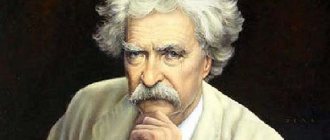What contributions did Sigmund Freud make to the development of psychology?
Sigmund Freud - Austrian psychoanalyst and psychiatrist.
He gained the greatest fame after
the discovery of psychoanalysis,
the discovery of which at one time greatly changed people's ideas about medicine, sociology and anthropology.
At the beginning of his scientific career, Freud deeply believed in the healing properties of hypnosis.
His fascination influenced Sigmund's thinking. But disappointment in this method forced the scientist to look for other ways. Trying to find a more advanced method, he used his own developed technique of free association, according to which the patient was asked to talk specifically without focusing on any topic suggested by the doctor. A person’s words should gradually lead to something more meaningful, which will help, firstly, to understand the essence of the problem, and secondly, to identify some reasons that would be very difficult to identify in any other way.
Freud's path to the discovery of psychoanalysis was difficult, unpleasant and sometimes even painful
.
Many friends and colleagues did not support his ideas and turned away from the scientist after his statement about the direct influence of sexual thoughts on hysteria and its manifestations. The statement was viewed with great skepticism. Around the same time, the scientist's father, Jakob Freud, died
, which was a real blow that drove Sigmund into despair.
Then he decided to apply the technique of free association to himself, where he examined his childhood memories, trying from a scientific point of view to understand the causes of his condition and find answers to tormenting questions. He finds some, but still remains dissatisfied with his research.
This dissatisfaction marked the beginning of psychoanalysis. But without finally achieving the desired result, Freud began to study dreams.
By examining his own dreams, Freud came to the conclusion that each element in a dream is the generated result of a whole series of hidden thoughts, which may not even be closely related and belong to different areas. In addition, associative thoughts do not go in order, as it might seem at first glance, but intersect and intertwine many times. He considered his work “The Interpretation of Dreams” to be his most important work. Freud could not find assistants who would want to study dreams. His friends and colleagues continued to be skeptical of Sigmund's tasks and solutions and underestimated his aspirations.
In addition, Freud made a major contribution by developing a three-component personality structure. (“It”, “I”, “Super-I”), where “It” is the basis for the manifestation of two other personalities, “I” is the human mind, his very personality, which controls processes in the psyche, and “Super-I” »
- inner voice.
Another important step in the development of psychology is the discovery of psychosexual stages of development
. Freud conducted research from the very beginning, when the body's methods of satisfaction are still infantile, to the end, when a person enters into sexual contact.
The scientist considered this discovery to be really important, because it is due to any violations during the passage of these stages that problems of a sexual, emotional and communicative nature appear in the future.
It is safe to say that after the discoveries made by Sigmund Freud, psychology reached a new level of development.
Biography of the founder of psychoanalysis
Sigmund Freud was born in a small town that at that time belonged to Austria and was called Freiberg; Now it is part of the Czech Republic and is called Příbor. Freud's parents were Jews and had a small business in the town - trading in fabrics. During the Industrial Revolution, Freud's family went bankrupt, and Freiberg itself fell into disrepair. The Freuds decided to change their place of residence and moved to Leipzig, and after some time to Vienna. Since the bankrupt family did not have much money, they had to settle in the poorest area of the city - Leopoldstadt.
This place was terrible; at that time it was inhabited by refugees, the poor, prostitutes, gypsies and other “dregs of society.” However, things gradually began to improve for the father, and the family was able to move to a more prosperous area. Sigmund Freud became interested in literature, and in general tried to study well. Jacob, the father of the future psychologist, sought to give him a decent education, even finding funds to enroll him in a private gymnasium.
In total, the Freud family had eight children. Seeing Sigmund's exceptional success in his studies, his parents tried to create a suitable atmosphere for him in the house. So, unlike other children, he was allocated a separate room and a kerosene lamp for classes; the rest of the children were forbidden to play music because it bothered Sigmund. He eventually graduated from high school with honors.
After graduating from high school, Freud had long doubts about his future path in life. He initially enrolled in medical school, but soon realized that medicine did not really interest him.
However, the first course was not exclusively related to medicine and contained various disciplines, mostly of a humanitarian nature.
Subsequently, Sigmund Freud became seriously interested in psychology and zoology. It was in zoology that he wrote his first scientific work - it was devoted to determining sexual differences in river eels. However, then psychology prevailed. Ernst von Brücke and Joseph Breuer had a significant influence on him in this sense. Freud became especially close to the latter: they had common interests, common views on life and, in addition, a common Jewish nationality. In the society of that time, including at the university, anti-Semitic sentiments dominated, and both thinkers had to somehow live, study and work in such conditions. Breuer, like Freud himself, stood at the origins of psychoanalysis.
After completing his studies and receiving a doctorate in medicine, Freud planned to stay at the university and engage in research. However, lack of funds forced him to take up medical practice. To begin with, he entered the Vienna City Clinic, where he first worked in the surgery department and then switched to neurology. Subsequently, Sigmund Freud worked as a psychiatrist. In the end, the study of human mental activity completely fascinated Freud.
In particular, Freud became interested in studying a new substance for that time - cocaine. Initially, he noted its positive properties and used it as a pain reliever. However, it later turned out that cocaine is not so harmless and useful.
In the 1890s, after completing an internship in Paris with the famous physician Jean Charcot, Freud became interested in treating patients with mental disorders. At first, he used traditional methods of that time, such as hypnosis and some others, but quickly realized their imperfection. He began to look for new methods of treatment and accidentally came across an essay by his favorite writer Ludwig Börne - “The Art of Becoming an Original Writer in Three Days.” The recommendations outlined in this essay led Freud to invent the method of free association. This was the beginning of a new direction - psychoanalysis.
Freud's books on psychoanalysis
Sigmund Freud's controversial ideas have permeated Western culture more deeply than those of any other psychologist. “Freudian error”, “Oedipus complex”, “Childhood sexuality”, “Libido”, “Narcissism”, “Penis envy”, “Castration complex”, “Id”, “Ego” and “Superego”, “denial” , “repression,” “identification,” “projection,” “pleasure principle,” “reality principle,” “defense mechanism” are all taken for granted in our everyday vocabulary.
Psychoanalysis has never been just a method of treatment, but rather a vision of the human condition. His central hypothesis, that we live in conflict with ourselves and seek to solve problems by turning our backs on reality, arose not from experimental science but from introspection and the unique observational possibilities presented by psychoanalytic technique.
A General Introduction to Psychoanalysis, written during the turmoil of the First World War, was taken from a series of lectures given at the University of Vienna, but it had to wait until the end of the war before the work became available to the English-speaking world.
His most famous theories
In addition to creating the psychoanalytic concept, Freud put forward many theories about the minds of people. Many of these theories were quite shocking for the times in which he lived. Here are some of his most memorable ideas:
- Oedipus Complex: Freud's most famous theory, the Oedipus complex, is that boys at a certain age develop a sexual attraction to their mothers. This attraction can become so strong that the boy can become very jealous of his father and even hate him.
- Id, Ego, Superego: In 1923, Sigmund theorized in The Ego and the Id that the mind is divided into three parts: the id, the ego, and the superego. These are not physical divisions, but rather conceptual ones. The id is located in our subconscious and moves towards physical pleasure such as breathing, eating and sex. The ego seeks to satisfy the desires of the id in a safe manner, while the goal of the superego is moral and socially acceptable behavior. Often these three parts of the brain compete with each other.
- Penis envy: This theory is that women begin to desire a penis at a young age, and the desire intensifies over time. Cause? Boys have more fun with their genitals than girls have with their genitals. Freud further theorized that as girls grow up, their penis envy manifests itself as a deep love for their dads and a desire to have a son—because that's the closest they'll ever get to not having a penis of their own.
Interesting facts about the life of a scientist
The widespread criticism of Sigmund Freud and his teachings was based not only on religious and ideological dogmas. Researchers showed that many of his patients "cured" by psychoanalysis were not actually cured and continued to suffer from their illnesses. This was, for example, the famous “wolf man” - the Russian landowner Sergei Pankeev, who was treated by Freud for depression for a long time. A patient of Freud's friend and like-minded person, Joseph Breuer, Anna O. suffered not from hysteria, as was stated, but from tuberculous meningitis, for which she was then treated for a long time.
Thus, these facts alone discredit Freud as a scientist and present him as a brilliant intellectual fraud.
The last days of the great scientist
The scientist spent the best years of his life in constant search and work. Freud's death shocked many. The man suffered from pain in the throat and mouth. A tumor was later found, due to which he underwent dozens of surgeries, losing the pleasant appearance of his face. Over the years of his life, S. Freud managed to make important contributions to many areas of human life. It would seem that with a little more time, he would have created much more.
But, unfortunately, the disease took its toll. The man made an agreement in advance with his attending physician, and when he no longer wanted to endure it, and there was no need to force all his relatives to watch this, S. Freud turned to him and said goodbye to this world. After the injection, he calmly fell into an eternal sleep.
Personal life and family of a scientist
The professional biography and personal life of Sigmund Freud are closely intertwined. It seems that it was love that pushed him to magnificent discoveries.
Medicine came easily to him, with the help of various diagnostic conclusions he came to psychoanalysis and made his own conclusions, made small observations and constantly wrote them down in his notebook. Sigmund knew that he could become a private doctor, and this would give him a good income. And he needed it for one big reason - Martha Bernays.
Sigmund first saw her when Martha came to his sister's house. Then the heart of the young scientist caught fire. He was not afraid to be frank and knew how to behave with the opposite sex. Freud's beloved received a gift from him every evening - a red rose, as well as a proposal for a meeting. This is how they spent their time secretly, because Martha’s family was very rich, and her parents would not allow an ordinary Jew to marry their daughter. After the second month of meetings, Shlomo confessed his love to Martha and proposed marriage. Despite the fact that her response was reciprocal, Martha’s mother took her out of town.
Young Shlomo decided not to give up and fight for marriage with the young beauty. And he achieved this after entering private practice. They lived together for more than 50 years and raised six children.
Other methods of Z. Freud
Freud later develops a method for analyzing dreams. It is with the help of them, as he argued, that the human problem can be solved. People dream dreams on purpose, in this way consciousness transmits a signal and helps to find a way out of the current situation, but people, as a rule, do not know how to do this on their own. Sigmund Freud began to receive patients and interpret their dreams; he listened to the most intimate secrets of his acquaintances and complete strangers, increasingly realizing that all difficulties were related to childhood or sexual life.
Such premises were again not liked by the community of psychoanalysts, but Freud began to develop the doctrine further.
Childhood
Sigmund always avoided talking about his childhood, although his parents loved their son and had great hopes for his future. That is why hobbies in literature and philosophy were encouraged. Despite his youth, Freud gave preference to Shakespeare, Kant and Nietzsche. In addition to philosophy, foreign languages, especially Latin, were a serious hobby in the young man’s life. The personality of Sigmund Freud truly left a serious mark on history.
His parents did everything to ensure that nothing interfered with his studies, which allowed the boy to enter the gymnasium ahead of time without any problems and successfully complete it.
However, upon graduation, the situation was not as rosy as expected. Unfair legislation provided a meager choice of future professions. Freud did not consider any other options besides medicine, considering industry and commerce to be unworthy sectors for the activity of an educated person. However, medicine did not inspire Sigmund’s love either, so after school the young man spent a lot of time thinking about his future. Psychology eventually became Freud's choice. A lecture on Goethe’s work “Nature” helped him make a decision. Medicine remained on the sidelines; Freud became interested in studying the nervous system of animals and published worthy articles on this topic.
Turning years
The years 1914-1919 were a big shock for the scientist; as a result of the First World War, he lost all his money and, most importantly, his daughter. Two more of his sons were on the front line at that time; he was in constant torment, worrying about their lives.
These sensations served to create a new theory - the death instinct.
Sigmund had hundreds of chances to become rich again, he was even offered to become a participant in the film, but the scientist refused. And in 1930 he was awarded a prize for his enormous contribution to psychiatry. This event once again elevated Freud, and three years later he began giving lectures on the topics of love, death and sexuality.
Old patients and strangers began to come to his performances. People asked Freud to hold private receptions for them, promising to pay huge sums of money.
Now Freud becomes a famous neurologist and psychiatrist, colleagues begin to use his works, refer to his methods and even request the right to use them in their own sessions.
For Freud, these were the best years of his life.










